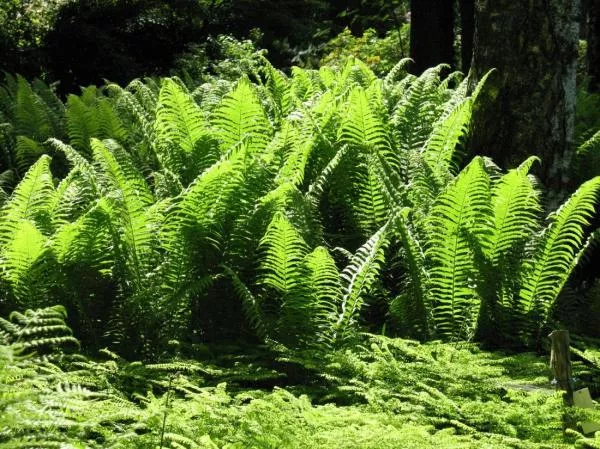
Seedless plants are one of the most archaic forms of life on our planet, but despite having existed since practically the beginning of life on Earth, today many of their species have become extinct, but many others still exist among U.S. Some are well known, such as ferns, which are in many parts of the world in nature and also in homes, but there is more variety.
If you still don't know them well and want to discover them, join us in this Green Ecologist article to learn a little more about them. seedless plants, their characteristics and examples easy.
Characteristics of seedless plants
Unlike angiosperms and gymnosperms, seedless plants do not produce, as their name suggests, seeds of any kind, and therefore they do not have flowers or fruits. Seedless plants are also characterized by their wide propagation due to their reproduction system, which we will detail a little below, and by having a waterproof cuticle, which makes them more resistant to sudden changes in the environmental climate. For this reason, although most seedless plants require humid environments to thrive, they are very resistant to droughts or areas with high intensity insolation.
Due to all these characteristics, they are usually the first vegetation to colonize arid areas or where the vegetation has been eradicated.
How seedless plants reproduce
This type of plant has two forms of reproduction: one sexual reproduction by spores, and one asexual reproduction by fragmentation.
Plants that reproduce by spores store the so-called spores in cavities or sacks under their leaves called sporangia, which keep them there until they are fertilized, at which time they are released so that external agents, such as air and water, transport them to new destinations. This type of reproduction has several advantages, such as that it consumes very little energy and that the spores are not as susceptible to animal predation as the seeds, since they have hardly any nutrients. In contrast, spores are more easily attacked by bacteria and fungi.
Reproduction by fragmentation occurs when a plant in contact with waterways detaches itself from a portion or fragment of itself so that it can be taken to a new area in which to fixate and grow.

Non-vascular seedless plants: examples of bryophyte plants
Bryophyte plants are non-vascular seedless plants, which are divided into mosses, hornworts, and liverworts. They are small plants, rarely reaching heights of up to 20 cm, and they always grow in humid places. They do not have stems, leaves, or roots themselves. Some Bryophyte plants or non-vascular seedless plants are:
Mosses
- Sphagnum: these mosses, commonly called peat mosses, are capable of retaining large amounts of water, which is why they are widely used in gardening to provide water balance.
- Polytrichum: the so-called hair moss gets its name from the hairs that cover it, thus giving it the appearance of a lush and dense carpet.
- Grimmia pulvinata: This moss produces formations of shades between green and gray, and tends to inhabit limestone rocks or walls and ceilings. It is the most common to see in cement.
Anthoceros
- Anthoceros agrestis: the so-called horn flower or field horn.
- Leiosporoceros dussii - This is the only species of its genus, and male specimens have not yet been found.
Hepatic
- Ricciocarpus natans - This liverwort is of the aquatic type and can be found in North and South America, as well as Europe, Japan, and southern Australia.
- Conocephalum conicum: Also called snake-skin liverwort or mushroom-head liverwort.
- Mannia rupestris: of the genus Mannia, comprising 13 accepted species.
Seedless vascular plants: examples of pteridophyte plants
The vascular seedless plants or pteridophyte plants count on vascular tissue, which is responsible for transporting water and nutrients through the interior of the plant. Thanks to this tissue, vascular plants have been able to develop to much larger sizes. Although, as with seedless plants in general, most of them have already become extinct, but we can still find some of them.
- The lycophytes They are very similar to mosses, but have vascular tissue. The resurrection plant is its most common example, which dries up but recovers after receiving water up to 14 years later.
- The ferns They are the most common to see today, and stand out for their striking and large fronds and for their characteristic violin heads, which give rise to the former. They are typical of the tropical jungles. In this other article we explain more about that Ferns are plants without flowers or seeds.
- Ponytails They have hollow stems like reed stems and are easy to find in swampy areas. Some of its varieties are the Equisetum arvense serotinum and the Equisetum arvense nemorosum.
- The psilotum they form green stems that branch devoid of leaves and with yellow sporangia, giving an appearance similar to that of a broom brush. Its two species are the Psilotum complanatum and the Psilotum nudum.
Find out more about them in this other article about Pteridophyte Plants: what they are, types and examples.

If you want to read more articles similar to Seedless plants: characteristics and examples, we recommend that you enter our Biology category.


